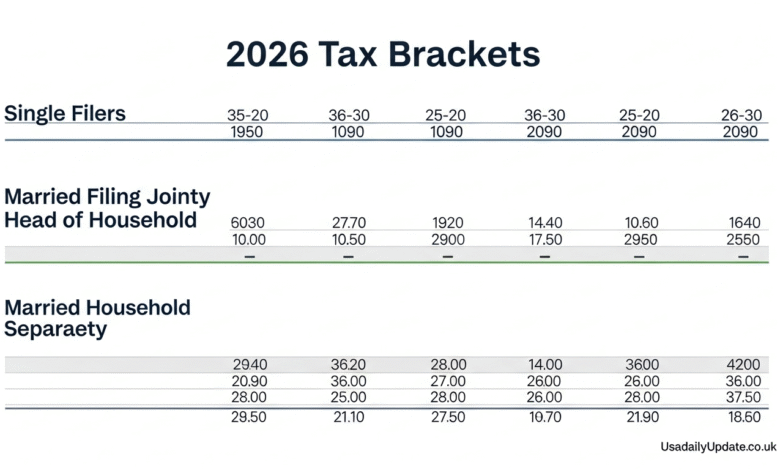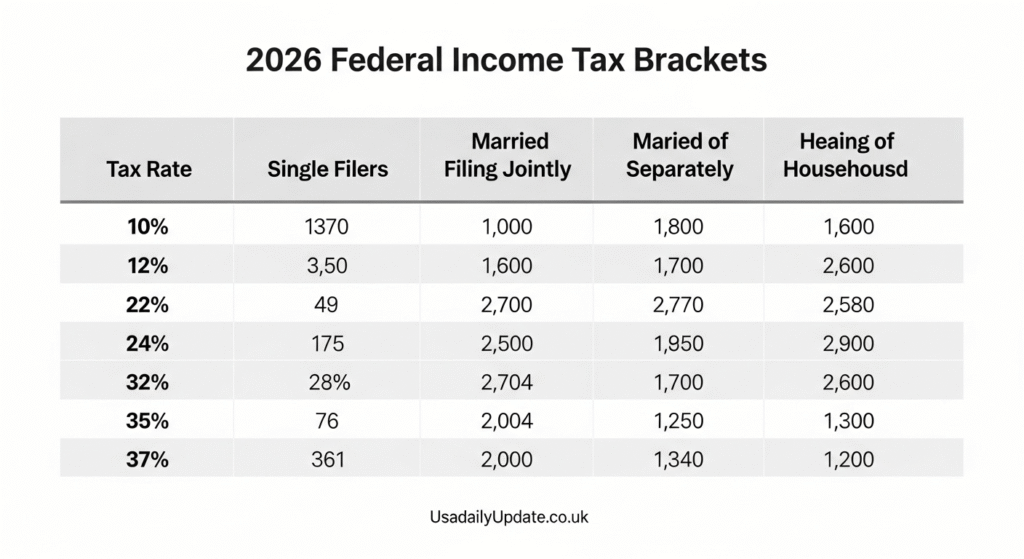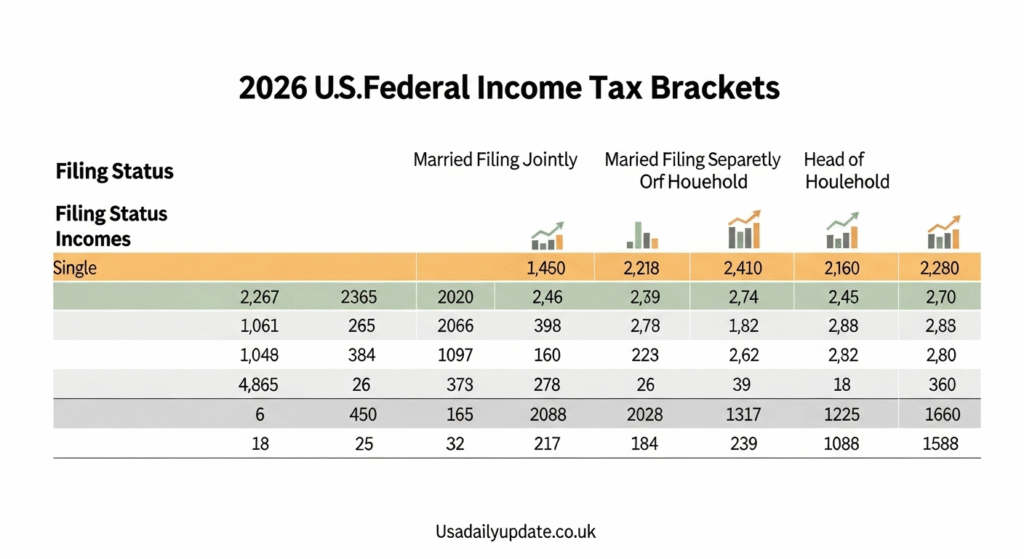2026 Tax Brackets: Essential Guide to Save Money Now

Introduction
Tax season always brings a mix of anxiety and confusion for most Americans. You’re probably wondering how much of your hard-earned money you’ll owe to Uncle Sam next year. Understanding the 2026 tax brackets is crucial for planning your finances and potentially keeping more money in your pocket.
The IRS adjusts tax brackets annually to account for inflation, and 2026 will be no different. These adjustments mean the income thresholds for each tax rate will shift, potentially moving you into a different bracket than you’re in now. Whether you’re a salaried employee, self-employed professional, or retiree, knowing where you fall in the 2026 tax brackets can help you make smarter financial decisions throughout the year.
This guide breaks down everything you need to know about the upcoming tax brackets. We’ll explore what the changes mean for your wallet, how to calculate your tax liability, and strategies to minimize what you owe. Let’s dive into the details so you can start planning ahead.
Understanding How Tax Brackets Work
Before we get into the specific 2026 tax brackets, you need to understand how the system actually works. Many people think if they move into a higher bracket, all their income gets taxed at that higher rate. That’s a common misconception that costs people money through poor financial decisions.
The U.S. uses a progressive tax system. This means different portions of your income get taxed at different rates. Only the income that falls within each bracket gets taxed at that bracket’s rate. The rest gets taxed at lower rates.
Think of it like filling buckets of different sizes. You fill the first bucket at the lowest rate, then move to the next bucket at a slightly higher rate, and so on. This continues until you’ve accounted for all your taxable income.
Your effective tax rate is what you actually pay overall. This rate is always lower than your top marginal rate because of this progressive system. Understanding this difference helps you make better decisions about raises, bonuses, and other income opportunities.
Projected 2026 Tax Brackets for Single Filers
While the IRS hasn’t officially announced the exact figures for 2026 tax brackets, we can make educated projections based on inflation adjustments and historical patterns. The tax rates themselves remain the same at 10%, 12%, 22%, 24%, 32%, 35%, and 37%.
For single filers in 2026, the projected brackets should look something like this. The 10% rate will likely apply to income up to approximately $11,600. The 12% bracket should cover income from about $11,600 to $47,150.
Moving up, the 22% rate will probably apply to income between $47,150 and $100,525. The 24% bracket should cover earnings from $100,525 to $191,950. Higher earners will see the 32% rate kick in from $191,950 to $243,725.
The 35% bracket will likely apply to income between $243,725 and $609,350. Finally, the top 37% rate affects income above $609,350. These figures represent increases from 2025 levels due to inflation adjustments.
Remember, these are projections based on expected inflation rates. The actual 2026 tax brackets might vary slightly when the IRS makes its official announcement, typically in late 2025.

Projected 2026 Tax Brackets for Married Filing Jointly
Married couples filing jointly generally benefit from more favorable tax brackets. The income thresholds are roughly double those for single filers, though not exactly.
For married couples filing jointly, the 10% rate should apply to income up to about $23,200. The 12% bracket will likely cover income from $23,200 to $94,300. This gives married couples significantly more room in the lower brackets.
The 22% rate should apply to income between $94,300 and $201,050. The 24% bracket will probably cover earnings from $201,050 to $383,900. These middle brackets are where many dual-income households find themselves.
Higher-earning couples will see the 32% rate apply to income from $383,900 to $487,450. The 35% bracket should cover income between $487,450 and $731,200. The top 37% rate kicks in for income above $731,200.
Filing jointly usually provides tax advantages for married couples. However, there are situations where married filing separately might make sense. It’s worth consulting with a tax professional to determine the best filing status for your specific situation.
Projected 2026 Tax Brackets for Head of Household
Head of household status provides a middle ground between single filer and married filing jointly rates. To qualify, you must be unmarried and pay more than half the costs of maintaining a home for yourself and a qualifying dependent.
For head of household filers, the 10% rate should apply to income up to approximately $16,550. The 12% bracket will likely cover income from $16,550 to $63,100. These thresholds give single parents and caretakers some tax relief.
The 22% rate should apply to income between $63,100 and $100,500. The 24% bracket will probably cover earnings from $100,500 to $191,950. Notice how these thresholds fall between single and married filing jointly amounts.
The 32% rate should kick in from $191,950 to $243,700. The 35% bracket will likely apply to income between $243,700 and $609,350. The top 37% rate affects income above $609,350.
Head of household status can save you significant money compared to filing as single. If you’re eligible for this status, make sure you claim it. Many people miss out on these savings simply because they don’t realize they qualify.
How Inflation Adjustments Affect Your Taxes
The IRS adjusts tax brackets annually based on the Consumer Price Index. This practice, called indexing, prevents “bracket creep” where inflation alone pushes you into higher tax brackets without any real increase in purchasing power.
For the 2026 tax brackets, the adjustments will reflect inflation rates from the previous year. Recent years have seen higher than normal inflation, which means larger adjustments to the brackets. This is actually good news for taxpayers.
Larger adjustments mean you can earn more money before moving into the next bracket. For example, if you got a 3% raise but the brackets increased by 3%, you effectively stay in the same tax situation. You’re not being penalized for keeping up with inflation.
Beyond the brackets themselves, the IRS also adjusts the standard deduction annually. This deduction reduces your taxable income before the brackets even apply. A higher standard deduction means less of your income is subject to tax.
These inflation adjustments are automatic and don’t require any action on your part. However, understanding them helps you plan your finances more effectively and take advantage of the tax code’s built-in protections against inflation.
Standard Deduction Changes for 2026
The standard deduction is one of the most important numbers in your tax return. It’s the amount you can subtract from your income before calculating your tax liability. For many Americans, taking the standard deduction is simpler and more beneficial than itemizing.
For 2026, the standard deduction should increase from 2025 levels due to inflation adjustments. Single filers can expect a standard deduction of approximately $15,000. This represents a meaningful increase that puts more money back in your pocket.
Married couples filing jointly should see a standard deduction around $30,000. This essentially doubles the single filer amount, providing substantial tax relief for married households. Head of household filers will likely have a standard deduction near $22,500.
Seniors get an additional boost. If you’re 65 or older, you receive an extra standard deduction amount. For 2026, this additional amount should be around $1,550 for single filers and $1,250 per person for married couples.
The higher standard deduction means fewer people benefit from itemizing deductions. You should only itemize if your deductible expenses like mortgage interest, state taxes, and charitable donations exceed the standard deduction amount.
Capital Gains Tax Rates for 2026
Capital gains taxes apply when you sell investments, real estate, or other assets for a profit. These rates are different from ordinary income tax rates and generally more favorable for long-term investments.
Short-term capital gains apply to assets held for one year or less. These gains are taxed at your ordinary income tax rates according to the 2026 tax brackets. There’s no special treatment for short-term gains.
Long-term capital gains apply to assets held for more than one year. These benefit from preferential tax rates of 0%, 15%, or 20%. The rate you pay depends on your overall taxable income.
For 2026, single filers with taxable income up to approximately $47,025 should pay 0% on long-term capital gains. Income between $47,025 and $518,900 faces the 15% rate. Above $518,900, the rate increases to 20%.
Married couples filing jointly get more favorable thresholds. The 0% rate should apply to income up to about $94,050. The 15% rate covers income from $94,050 to $583,750. The 20% rate kicks in above $583,750.
Additionally, high earners may face the Net Investment Income Tax, an additional 3.8% tax on certain investment income. This applies when your modified adjusted gross income exceeds specific thresholds.
Smart Tax Planning Strategies for 2026
Understanding the 2026 tax brackets is just the first step. You need strategies to minimize your tax liability legally and effectively. The earlier you start planning, the more options you have.
One powerful strategy is maximizing retirement contributions. Money you put into traditional 401(k) plans and IRAs reduces your taxable income for the year. For 2026, contribution limits will likely increase due to inflation adjustments.
If you’re on the edge of a tax bracket, small adjustments can make a big difference. Consider timing bonuses, selling investments, or making deductible expenses strategically. Sometimes deferring income to the next year or accelerating deductions into the current year makes sense.
Tax-loss harvesting can offset capital gains. If you have investments that have lost value, selling them can create losses that offset gains from other investments. This strategy requires careful planning and understanding of wash sale rules.
Health Savings Accounts offer triple tax benefits. Contributions are tax-deductible, growth is tax-free, and withdrawals for qualified medical expenses are tax-free. If you have a high-deductible health plan, maxing out your HSA is one of the best tax moves you can make.
Charitable giving provides deductions if you itemize. Donating appreciated securities can be especially tax-efficient because you avoid capital gains taxes and get a deduction for the full market value.
Common Tax Mistakes to Avoid in 2026
Even with knowledge of the 2026 tax brackets, people make costly mistakes every year. Avoiding these errors can save you money and headaches during tax season.
One common mistake is choosing the wrong filing status. Your filing status significantly impacts your tax liability. Make sure you’re using the status that provides the best outcome for your situation. If you’re unsure, run calculations both ways.
Many people overlook deductions and credits they’re entitled to claim. Education credits, child tax credits, earned income tax credits, and others can substantially reduce your tax bill. Don’t leave money on the table by missing these opportunities.
Not adjusting your withholding after major life changes is another frequent error. If you got married, had a child, bought a house, or changed jobs, review your W-4 form. Proper withholding prevents surprises at tax time.
Failing to keep good records causes problems. Save receipts, track expenses, and maintain documentation for deductions you plan to claim. Digital tools and apps make this easier than ever.
Waiting until the last minute to deal with taxes creates stress and increases error risk. Start organizing early, gather your documents, and consider working with a tax professional if your situation is complex.
Tax Credits vs. Tax Deductions
Understanding the difference between tax credits and deductions is crucial for minimizing your 2026 tax liability. They both reduce what you owe, but they work in very different ways.
Tax deductions reduce your taxable income. They work within the framework of the 2026 tax brackets. If you’re in the 22% bracket, a $1,000 deduction saves you $220 in taxes. The value of deductions depends on your marginal tax rate.
Tax credits directly reduce your tax bill dollar for dollar. A $1,000 tax credit saves you $1,000 regardless of which bracket you’re in. This makes credits more valuable than deductions of the same amount.
Some credits are refundable, meaning you can get money back even if you owe no taxes. The Earned Income Tax Credit and Child Tax Credit are partially refundable. These credits are especially valuable for lower and middle-income families.
Non-refundable credits can only reduce your tax liability to zero. You don’t get the excess back as a refund. Examples include the Lifetime Learning Credit and certain energy efficiency credits.
Common valuable credits for 2026 include the Child Tax Credit, Child and Dependent Care Credit, American Opportunity Tax Credit, and Saver’s Credit. Research which credits you might qualify for and make sure to claim them.
How the 2026 Tax Brackets Compare to Previous Years
Looking at how the 2026 tax brackets compare to previous years gives you context for planning. The tax rates themselves have remained stable since the Tax Cuts and Jobs Act of 2017.
The seven tax rates of 10%, 12%, 22%, 24%, 32%, 35%, and 37% have been consistent. What changes annually are the income thresholds for each bracket. These adjustments track with inflation to protect taxpayers.
From 2025 to 2026, you can expect the brackets to increase by roughly 2% to 3%, depending on final inflation figures. This is lower than the increases seen in 2023 and 2024 when inflation was running hotter.
The current tax structure is set to expire after 2025 unless Congress acts. However, there’s significant political pressure to extend or make permanent many provisions. The 2026 tax brackets operate under the assumption that current law continues.
If the tax cuts expire, brackets would revert to their pre-2018 structure with different rates and thresholds. This would represent a significant tax increase for many Americans. Stay informed about potential legislative changes that could affect your taxes.
State Income Taxes and How They Interact
While we’ve focused on federal 2026 tax brackets, don’t forget about state income taxes. Most states have their own income tax systems that work alongside the federal system.
Some states have no income tax at all. Alaska, Florida, Nevada, South Dakota, Tennessee, Texas, Washington, and Wyoming don’t tax wage income. New Hampshire only taxes dividend and interest income.
Other states have flat tax rates where everyone pays the same percentage regardless of income. Illinois, Indiana, Michigan, and Pennsylvania are examples. These systems are simpler but less progressive than graduated brackets.
Many states use progressive tax brackets similar to the federal system. California, for instance, has some of the highest state tax rates in the nation with brackets reaching 13.3% for top earners.
Your state taxes might be deductible on your federal return if you itemize. However, the state and local tax deduction is capped at $10,000. This limitation has made state taxes more burdensome for residents of high-tax states.
Consider state taxes when making major financial decisions. Moving to a state with no income tax can significantly impact your take-home pay, though you should consider overall cost of living and other factors too.
How Self-Employment Affects Your Tax Situation
If you’re self-employed, the 2026 tax brackets apply to you, but with some important differences. Self-employed individuals face additional taxes and have different planning considerations than W-2 employees.
Self-employment tax is your first extra burden. This covers Social Security and Medicare taxes that employers normally pay half of. The self-employment tax rate is 15.3% on net self-employment income up to certain thresholds.
The good news is you can deduct the employer-equivalent portion of self-employment tax. This deduction reduces your adjusted gross income, effectively lowering the amount subject to the 2026 tax brackets.
Quarterly estimated tax payments are required for self-employed individuals. You can’t wait until April to pay your taxes. The IRS expects payments throughout the year as you earn income.
Self-employed people have access to valuable deductions unavailable to employees. Home office deductions, vehicle expenses, equipment purchases, and business insurance can all reduce your taxable income significantly.
Consider setting up a SEP IRA or Solo 401(k) for retirement savings. These plans allow much higher contribution limits than traditional IRAs, potentially saving substantial tax dollars while building retirement security.
Retirement Account Contributions and Tax Benefits
Retirement accounts offer some of the best legal tax shelters available. Understanding how they work within the 2026 tax brackets helps you maximize benefits.
Traditional 401(k) and IRA contributions reduce your current taxable income. If you contribute $20,000 to a 401(k) and earn $100,000, you’re only taxed on $80,000. This can potentially drop you into a lower bracket.
For 2026, the 401(k) contribution limit should increase to around $23,500 for those under 50. If you’re 50 or older, catch-up contributions allow an additional $7,500. These limits adjust with inflation.
Traditional IRA contribution limits will likely be around $7,000 for 2026, with a $1,000 catch-up contribution for those 50 and over. However, your ability to deduct IRA contributions may be limited if you or your spouse has a workplace retirement plan.
Roth accounts work differently. Contributions don’t reduce current taxes but grow tax-free and come out tax-free in retirement. Roth conversions can make sense if you expect to be in a higher bracket later.
The Saver’s Credit provides additional benefits for lower and middle-income taxpayers who contribute to retirement accounts. This credit directly reduces your tax bill and is often overlooked.
Planning for Alternative Minimum Tax
The Alternative Minimum Tax is a parallel tax system that ensures high earners pay a minimum amount of tax. While fewer people face AMT after recent tax reforms, it still affects some taxpayers.
AMT uses different rules for calculating taxable income. Many deductions allowed under regular tax rules get disallowed or limited under AMT. State and local tax deductions, for example, aren’t allowed under AMT.
For 2026, the AMT exemption amounts should increase with inflation. Single filers will likely have an exemption around $85,700, while married couples filing jointly should see an exemption near $133,300.
The AMT has two rates: 26% and 28%. These rates apply after your exemption amount. The exemption begins to phase out at higher income levels, effectively creating higher marginal rates.
If you’re subject to AMT, timing certain income and deductions becomes more complex. Strategies that work under the regular tax system might not help with AMT. This is where professional tax advice becomes particularly valuable.
Exercising incentive stock options often triggers AMT. If you have ISOs, carefully plan when and how many to exercise to minimize unintended tax consequences.

The Impact of Life Changes on Your Taxes
Major life events can significantly affect how the 2026 tax brackets apply to you. Planning for these changes helps you avoid tax surprises.
Getting married changes your filing status and potentially your bracket. Running the numbers before tying the knot helps you understand the tax implications. Sometimes couples face a marriage penalty, other times they benefit from marriage bonuses.
Having a child brings valuable tax benefits. The Child Tax Credit is worth up to $2,000 per child under 17. The Child and Dependent Care Credit helps offset childcare costs. These credits can substantially reduce your tax liability.
Buying a home affects your taxes in multiple ways. Mortgage interest may be deductible if you itemize. Property taxes are also deductible, though subject to the $10,000 state and local tax cap.
Divorce or separation requires careful tax planning. Determining who claims children as dependents, how alimony is treated, and the optimal filing status are all important considerations.
Starting a business or becoming self-employed dramatically changes your tax situation. You gain access to business deductions but face self-employment taxes and estimated payment requirements.
Job loss or significant income changes should prompt withholding adjustments. If your income drops, you might move to a lower bracket, potentially creating opportunities for Roth conversions or other strategies.
Tax Software and Professional Help
With the complexity of the 2026 tax brackets and tax law generally, you need to decide how to prepare your return. You have options ranging from free software to expensive professionals.
For simple tax situations, free software options exist. If you only have W-2 income and take the standard deduction, free filing through IRS Free File or other programs works well.
Commercial tax software like TurboTax, H&R Block, and TaxAct offer more features and guidance. These programs ask questions and fill out forms for you. They’re good for moderately complex situations and cost much less than professionals.
Enrolled agents specialize in tax matters and can represent you before the IRS. They’re less expensive than CPAs but have specialized tax knowledge that general accountants might lack.
Certified Public Accountants offer comprehensive financial advice beyond just tax preparation. If your financial situation is complex, a CPA can provide year-round planning and strategic advice.
Tax attorneys are necessary for certain situations like audits, tax disputes, or business structures. They’re the most expensive option but essential when you have serious tax issues.
Consider your situation’s complexity, your comfort level with tax rules, and your budget when choosing. For many people, software works fine. As your financial life becomes more complex, professional help becomes more valuable.
Conclusion
Understanding the 2026 tax brackets puts you in control of your financial future. These brackets determine how much of your income goes to taxes and influence countless financial decisions throughout the year. By knowing where you fall in the bracket system, you can make smarter choices about retirement contributions, investment timing, and income planning.
The projected brackets for 2026 reflect continued inflation adjustments that protect taxpayers from bracket creep. Whether you’re a single filer, married couple, or head of household, these thresholds directly impact your tax liability. Taking time to understand your specific situation and planning accordingly can save you thousands of dollars.
Remember that tax planning is a year-round activity, not just something you do in April. The strategies we’ve discussed work best when implemented throughout the year. Consider working with a tax professional if your situation is complex or if you want personalized guidance.
How do you plan to adjust your tax strategy for 2026? Start reviewing your withholding, maximizing deductions, and positioning yourself to take full advantage of the tax code’s opportunities.
Frequently Asked Questions
What are the 2026 tax brackets for single filers?
The 2026 tax brackets for single filers will range from 10% to 37% across seven brackets. The lowest 10% rate should apply to income up to approximately $11,600, while the highest 37% rate applies to income above $609,350. These figures are projections based on expected inflation adjustments.
How much is the standard deduction for 2026?
The standard deduction for 2026 is projected to be around $15,000 for single filers and $30,000 for married couples filing jointly. Head of household filers should see a standard deduction near $22,500. Seniors 65 and older receive additional amounts on top of these figures.
Will the 2026 tax brackets change significantly from 2025?
The 2026 tax brackets should increase by approximately 2% to 3% from 2025 levels due to inflation adjustments. The tax rates themselves remain the same at 10%, 12%, 22%, 24%, 32%, 35%, and 37%. Only the income thresholds for each bracket will increase.
How do I calculate my effective tax rate using the 2026 tax brackets?
Your effective tax rate is your total tax divided by your total income. Because of the progressive bracket system, you pay different rates on different portions of your income. Add up the tax from each bracket, divide by your total taxable income, and multiply by 100 to get your effective rate percentage.
Do capital gains count toward my tax bracket?
Long-term capital gains are taxed at preferential rates of 0%, 15%, or 20% depending on your total taxable income. However, capital gains are included when determining which capital gains rate applies to you. Short-term capital gains are taxed as ordinary income according to the regular 2026 tax brackets.
What happens if I move to a higher tax bracket during the year?
Only the income above the bracket threshold gets taxed at the higher rate. If you move from the 22% bracket to the 24% bracket, only the dollars above that threshold are taxed at 24%. Your income below the threshold is still taxed at the lower rates.
Can I reduce my taxable income to stay in a lower bracket?
Yes, through strategies like maximizing retirement contributions, taking business deductions if self-employed, making charitable donations if itemizing, contributing to Health Savings Accounts, and timing income and expenses strategically. These legal methods can reduce your taxable income and potentially keep you in a lower bracket.
How does married filing separately compare to married filing jointly for 2026?
Married filing jointly typically provides better tax treatment with higher bracket thresholds. Married filing separately uses different brackets that are generally less favorable. However, separate filing might make sense in specific situations like when one spouse has significant medical expenses or student loan considerations.
Will the 2026 tax brackets expire or change?
The current tax structure is scheduled to expire after 2025 under current law. However, Congress may extend or modify these provisions. Stay informed about potential legislative changes that could affect the 2026 tax brackets and your tax situation.
What income is used to determine my tax bracket?
Your taxable income determines your bracket, not your gross income. Taxable income is calculated by taking your total income, subtracting adjustments like retirement contributions and student loan interest, then subtracting either the standard deduction or itemized deductions. This final number determines which brackets apply to you.
Also Read Usadailyupdate.co.uk



